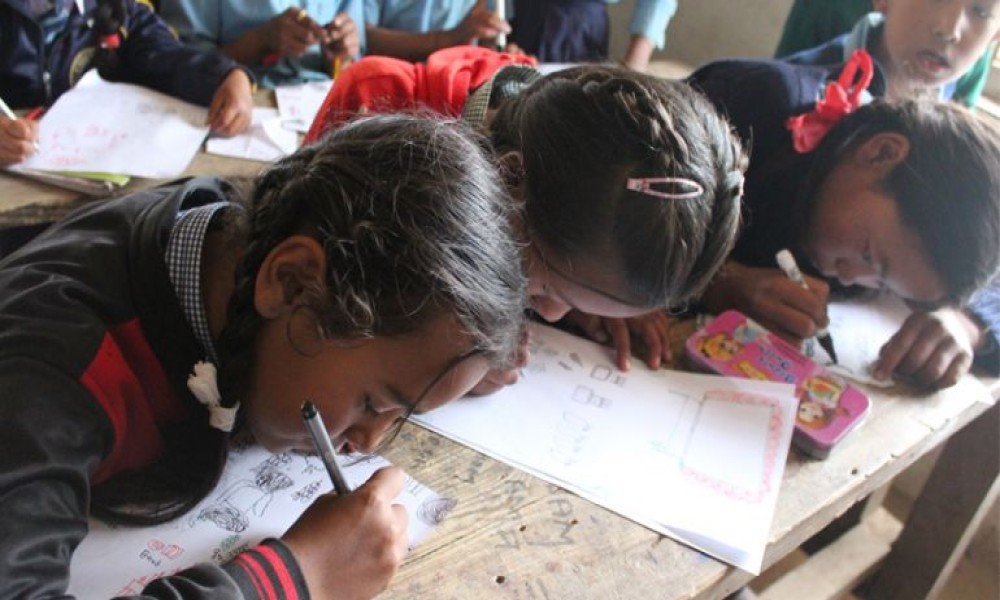A fresh debate is now raging in Nepal over whether Sanskrit should be taught to children in schools. The debate was sparked by the Curriculum Development Center (CDC), which has recently prepared the Sanskrit text book for Grade 1. The CDC is preparing more text books for other grades.
Those who favor the return of Sanskrit in schools argue that it is 'the base of the oriental philosophy' and 'the source of wisdom', so it should be taught and promoted. To prove their point, they also argue that even some international universities and institutions, including the National Aeronautics and Space Administration (NASA), are conducting researches on Sanskrit.
But those who are opposed to Sanskrit education at the school level are asking some important questions: why would the State need to invest in the promotion of Sanskrit from the school level when it is already funding Sanskrit school and universities? Is it in tune with constitutional provisions and National Education Policy regarding mother tongues?
Tika Bhattarai and Amrit Yonjan of Language Concern Group have urged the Education Minister to not re-start Sanskrit education in schools. Other linguists, education experts and Nepal Federation of Indigenous Nationalities (NEFIN) have also opposed the decision to introduce Sanskrit education in schools.
Tika Bhattarai and Amrit Yonjan of Language Concern Group have urged the Education Minister to not re-start Sanskrit education in schools. Other linguists, education experts and Nepal Federation of Indigenous Nationalities (NEFIN) have also opposed the decision to introduce Sanskrit education in schools.
History of Sanskrit education in Nepal
Sanskrit is a very old Indo-Aryan language. It was the medium of education in Gurukuls in ancient times. In modern era, Sanskrit education was started institutionally in Nepal in 1932 BS when Sanskrit schools were opened in Dingla of Bhojpur. In 1942 BS, Tindhara Sanskrit School was opened in Kathmandu. Sanskrit schools were opened in other places as well, which collectively lay the foundation of Sanskrit education in the country.
In 2008 BS, Rajkiya Sanskrit and Pindeshwar Mahabidhyalaya were founded as Sanskrit universities. Sanskrit universities were established in Dang, Janakpur and Matihani as well. In 2030, an institute was set up at Tribhuvan University for researches about Sanskrit, which is now known as Balmiki Sanskrit Campus.
Mahendra Sanskrit University was established in 2043 BS with its central office in Beljhundi of Dang district. Sanskrit educational institutes were set up in Ridi of Gulmi, Janakpur and Mehendranagar. Mahendra Sanskrit University has been renamed as Nepal Sanskrit University. According to a report published by the Ministry of Education in 2075 BS, this university has 18 campuses including 14 constituent campuses, but there are only 1,471 students.
During much of the Panchayat era, Sanskrit was a compulsory subject in schools. However, development of Sanskrit education was not as expected.
During much of the Panchayat era, Sanskrit was a compulsory subject in schools. However, development of Sanskrit education was not as expected. In 2049 BS, National Education Commission had presented the reasons behind the failure of Sanskrit education in Nepal: focus on learning rather than the medium and lack of training to Sanskrit teachers.
Controversy over Sanskrit language
Sanskrit education became a controversial issue after the restoration of democracy in 1990. Emboldened by the new political environment, indigenous communities spearheaded a sustained movement for rights to education in various mother tongues and their recognition as official language in government offices.
NEFIN opposed the idea of making Sanskrit a compulsory subject in schools, arguing that Sanskrit is not spoken by Brahmins themselves any longer and children belonging to indigenous communities are struggling in education because they are not taught in their mother tongues.
The Constitution of 1990 guaranteed indigenous communities' rights to their languages, scripts and culture, and access to primary education in mother tongues. But the Constitution also declared Khas-Nepali language as the language of the nation and official language. Higher status to Khas-Nepali language left indigenous communities indignant. Meanwhile, Bishwa Hindu Mahasangh, an association of Hindu nationalists, pressed the government and the National Education Commission (NEC) in 2049 BS to include Sanskrit as a compulsory language in schools.
But the NEFIN opposed the idea of making Sanskrit a compulsory subject in schools, arguing that Sanskrit is not spoken by Brahmins themselves any longer and children belonging to indigenous communities are struggling in education because they are not taught in their mother tongues. Therefore, Sanskrit and mother tongues both were introduced only as optional subjects. But the NEC proposed at least one Sanskrit school in every district, setting up of Sanskrit education monitoring unit and scholarship to attract women and students from various ethnic communities to Sanskrit education. The NEC also put forth recommendations for introducing Sanskrit education in higher education, Ph.d and M.phil.
This is part of the unauthorized translation of the article originally published in Kantipur daily. To read the full original article in Nepali: https://ekantipur.com/koseli/2020/05/30/159080940235378506.html?fbclid=IwAR2nEPElyyWp83D83CCB-MExvZgseyeY_RvsB7ypRshaRhvVrLcTeoDLpRY








